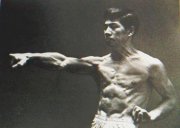Following on from Empty Hand Part 3, your friendly neighbourhood Rogue Advisor presents you the with next mighty kata in order of advancement through the formal Karate gradings.
This powerful display of Shotokan prowess does what it says on the tin. This is the Kata you need when you really have to kick seven shade of s**t out of every mother fu**er in the place. Bassai Dai means ‘To Storm a Castle’.
It is the first of two such brutal katas; they do not follow the Embusen or ‘H’ shaped path of the five katas presented in Empty Hand Part 2, but move at varying different angles as if attacking and being attacked by multiple attackers in a close environment.

This is how you storm a castle D&D style. Non-D&D players will have to use that seldom come by stuff called imagination. D&D is awesome. Deal with it.
Kata History
Born in 1796, Sokon ‘Bushi’ Matsumura created Bassai Dai, he was a pioneer of the practice and the development of the Okinawan style of Shuri Te. He began his training at the age of 14, by the age of 25 he was acknowledged for his achievements in Martial skill. Matsumura’s combat prowess and fearsome reputation got him a massive promotion as Chief Of Security to the Okinawan King. In effect he was head bodyguard.
An honourable position, but an unenviable one, the Okinawan King was little more than a puppet to the Japanese overlords. It was these same overlords who banned the carrying of weapons on Okinawa, (ironically triggering the birth of both Karate and Kobudo), even the bodyguards to the Okinawan King were not allowed to carry weapons. Making them the only bodyguards to a head of state in history who were not allowed to carry weapons.

Due to the technology of Japan’s isolation at that time, this is the best picture you’re gonna get of him. Deal with it.
In 1853, Japanese isolationism was forcibly ended by an American fleet led by Commodore Perry. An often overlooked footnote of history is that Perry stopped at Okinawa merely for supplies, before going to Japan to go about his true business.
Whilst seeming arrogant and headstrong, Perry understood the Japanese mindset at that time. He deliberately set about bullying the unarmed Okinawan’s so that when he arrived at Japan he would bring with him a pugilistic reputation.
The Okinawan’s had no clue as to Perry’s true intentions; likely, they would have viewed it as an invasion. When Perry led a parade up to the Shuri Castle, (the King’s own centre of government), joined by 2 companies of armed US marines, 50 naval officers, 2 brass bands, and some big f**k you Okinawa cannons from the ships! EEK!
Despite the odds, a lot of non-Okinawan ass was kicked that day. Perry didn’t attain the reputation he desired. That’s bullying for you.
Everybody working for the King, whether they were a Head Of State or just a Clerk, would be required to be a very competent Martial artist. If a situation broke out, everybody would be expected to jump in and help out.
It is also known that Matsumura studied psychology diligently; one tale of how another Okinawan already skilled at Karate asked Matsumura to teach him. Matsumura refused, so the other man challenged Matsumura to a duel. Matsumura, knowing that the other man was superstitious agreed, but set the time and place for the duel at dawn by a graveyard.
A very spooky setting for a superstitious man. When they met and confronted each other, Matsumura issued a loud kiai, (shout), and the other man surrendered without a single blow being struck. That is the definition of the art of fighting without fighting, eh?
The sanity of the King of Okinawa was slowly diminishing, he issued a proclamation that Matsumura could defeat a bull without consulting Matsumura. He set a date for the duel. With a freakin’ bull. However, Matsumura knew the keeper of the mighty bovine in question and made an arrangement with him.
Each night for a week preceding the duel, the bull would be penned up so tight that it could not move. On the day of the duel, the bull was close to being crippled, the spectators, didn’t seem to realise this was abnormal. The unhealthy bull was released into the ring; Matsumura glared at the bull, the beast took one look and run away in fear.
During the American bombing on Okinawa in World War 2, most of the records of this time were destroyed. However, the irony of history is that records taken by Perry and his crew during this time gives us all the insight we need. Paintings and photographs taken by Perry’s expedition show that when Perry lead his parade to the Shuri Castle.
So what’s all this got to do with the kata?
OK, back to Bassai Dai
Suckers that ‘we’ are for consistency here at Level Up, once again our instructor will be the Shotokan Karate legend himself
先 生 金 澤 弘 和
Sensei Hirokazu Kanazawa

Sensei Kanazawa demonstrates a perfect Yoko tobi geri. Deal with it. Bet you can’t.
披 塞 大
Bassai Dai
The Bunkai
That’s right, beloved reader, even though you can clearly see that Sensei Kanazawa had to slow his movements for the audience in the demonstration below, you can clearly see that the bunkai work. At the risk of sounding arrogant, you friendly neighbourhood Rogue Advisor has had to employ these tactics against some of the less desirable denizens of Southend-On-Sea and Hackney, (South-East ‘Brooklyn’ level violence areas, for non-British readers).








